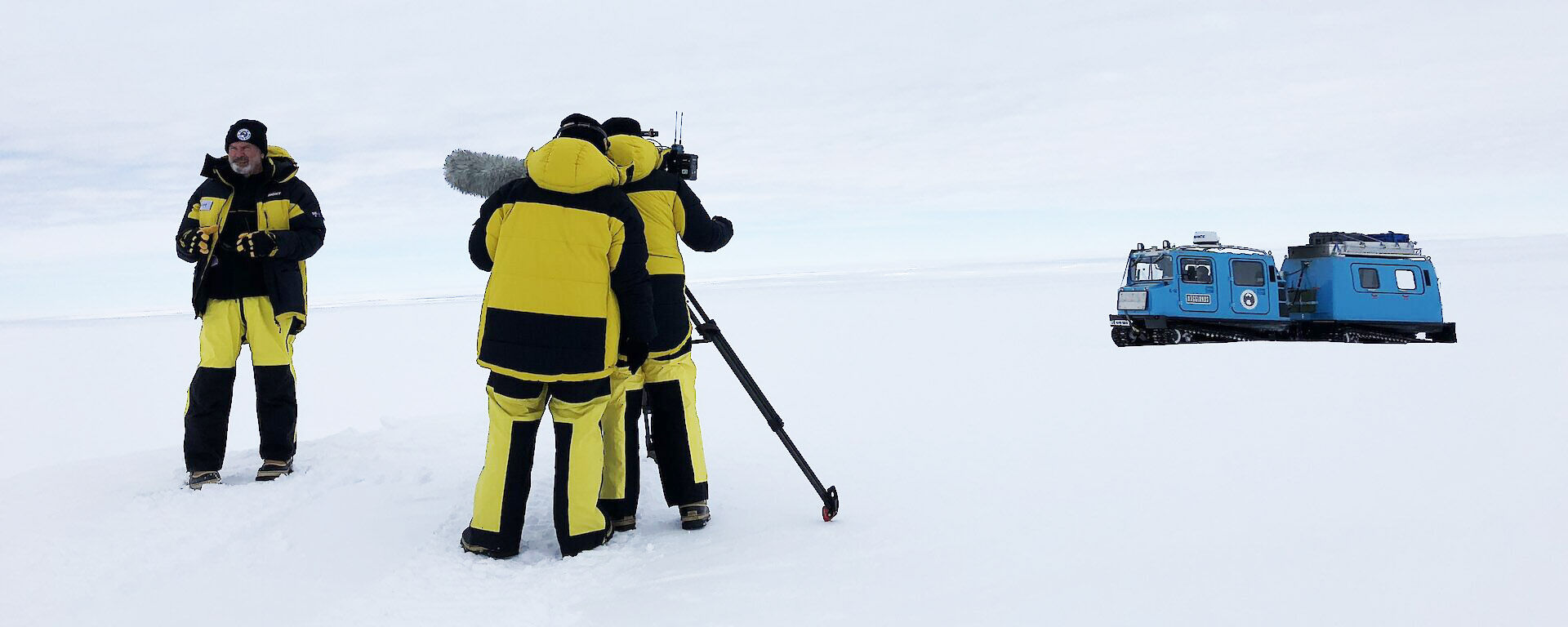Antarctic video gallery
Midwinter subzero swim
Video transcript
David Knoff — Davis Station Leader
“Here we are at the Davis pool for the annual midwinter swim, the temperature is a balmy minus 22 odd degrees, but thankfully there’s no wind. The lovely pool here today has been prepared by the plant operators and the diesos. Thanks to them and the expeditioners behind me are looking forward to jumping in for a nice warm bath.”
Jason Beachcroft — Davis Field Training Officer
“This is stupid and I just want you all to know that.”
Question: “Would you like to say anything to people at home?”
Ben Harrison — Davis Plumber
Answer: “Yes, I wouldn’t recommend this!”
David Knoff — Davis Station Leader
“And that concludes our coverage of the Davis 1.5 metre freestyle, thanks for watching!”
[end transcript]
We are equal
Video transcript
We are equal - Australian Antarctic Program
Kim Ellis, Director, Australian Antarctic Division: “The original Antarctic programs were built on that great age of exploration at the turn of the 19th century, people like Mawson and Scott, Amundsen, all bearded white men, trekking across the Antarctica and for a long time our program replicated that but that time has passed, what we have started to do is transition into a program that’s got diversity in it. Through that diversity it has given us a much more robust basis on which to build a great world-class program."
Women are now an integral part of all aspects of our operations.
Currently about quarter of Australia’s Antarctic population are women.
Women have led Australia’s Antarctic and sub-Antarctic stations since 1989.
Kat Panjari, Station Leader: “The thing I like most about being a station leader is bringing a diverse team of people together, from all sorts of different technical backgrounds, and having a shared vision contributing to the science program of the Australian Antarctic Division.”
We are at the cutting edge of new discoveries.
Dr Dana Bergstrom, Terrestrial Ecologist: “Antarctica is the end of the planetary spectrum for life. And here we’re in a very saline, desert area and we’re still finding life. And that’s what really excites me.”
Our work aims to lead and inspire other Antarctic nations.
Rebecca McWatters, Remediation Analyst: “Our project has been working on researching and developing remediation techniques for the last 20 years. We’ve worked across all the Australian stations, and we’ve also collaborated with a lot of different other nations.”
More than the science. Women are key to all aspects of Antarctic life. From field training. To engineering. From food. To aviation.
Dr Jan Wallace, Antarctic Medical Practitioner: “We’re about to receive a plane here from Davis, so I’m up here in several roles. Hopefully not as the doctor, because that would be part of an emergency response, today I’ve been the Hägg driver and chauffeur for the new passengers coming home.”
Back at Head Office, about 40% of the workforce is female.
Sarah-Jane Sheehy, Business Support Lead: “We have staff in various locations and at all our Antarctic stations, so my role involves a lot of governance work, risk management, operational procedures. We support such a diverse workforce and I love collaborating with lots of different stakeholders who specialise in different areas to support the AAP.”
Some roles support expeditioners who head south.
Deb Carwana, Expedition Clothing Store Officer: “We have a lot of tradespeople right through to scientists, people looking after birdlife, media people, it’s really, really vast actually and quite interesting. You meet all kinds of different people.”
Others are involved in operations.
Leanne Millhouse, Shipping Officer: “When I am on a voyage or I am summering, I am constantly either looking out of my office window or looking out of the bridge window, or the cabin window and this is my office I am lucky enough to get paid to do this. It’s a really positive experience, everyone’s really positive and everyone wants everyone to succeed.”
On the international stage, we lead Southern Ocean conservation efforts.
Dr Virginia Andrews Goff, Whale Biologist: “We have different populations of whales, targeting different types of krill, which has a flow on effect in terms of your ecosystem management practices around krill fisheries, around protecting whales and how we can feed that information up the line to policy makers, is really huge.”
We also lead on the international stage, spearheading Southern Ocean conservation efforts.
Gill Slocum, Australian Commissioner CCAMLR: “CCAMLR operates by consensus and that can be quote challenging at times because we need to get all 25 members to agree. However there’s a lot of strengths in consensus.”
While the Program has become more inclusive, it will only get bigger and better as we pursue equality.
Dirk Welsford, Science Program Leader: “That we make sure women have fair and equitable access to opportunities, whether that’s for leadership, for promotion, for getting jobs because no one has a monopoly on good ideas, I’ve certainly found that in my science career. Having a really good diverse cross section of the society inside the AAD is the best way for us to be successful.”
Our Commitment
The Australian Antarctic Division is committed to gender equality across all levels of the organisation.
Our Goals
AAD staff are proactive in driving gender equality.
AAD is an employer of choice recognised for its gender equality practices.
Increased number of women across all roles.
Our Actions
Implement Gender Equality Strategy
Provide flexible + supportive working arrangements
Offer networking, leadership and mentoring opportunities.
Ensure gender neutral recruitment processes
We will help you
Step up and take a proactive role
Call out issues
Embrace gender equality
Kim Ellis, Director, Australian Antarctic Division: “It’s really important that we embrace the diversity and we seek equity and equality in what we do, because it will bring to the program the very best in Australia, in the world, to actually deliver our responsibilities against the 20 Year Strategy and Action Plan.”
[end transcript]
It's a bit breezy
Video transcript
Mawson research station is nestled on the coast of East Antarctica.
Where the ice cap falls steeply to the sea.
As winter sets in, fearsome gravity-fed ‘katabatic’ winds roar down the slope.
The 19 Australians at Mawson have just endured an epic seven day blizzard.
The wind blew between 100-148 km/h, with one gust reaching 244 km/h.
Visibility was zero for days on end.
As conditions eased, expeditioners headed out to check for damage.
While the force of the winds moved fully laden shipping containers, there were no major issues.
For safety, the team followed a rope or ‘blizz line’ to move between buildings.
Moving even a small distance in Antarctic storms is a feat of strength and endurance.
[end transcript]
Helping Hand
Video transcript
At a time when hand sanitiser is hard to find, our science labs have all the makings
DIRK WELSFORD, Scientist, Australian Antarctic Division:
It’s basically ethanol, glycerol, and a little bit of hydrogen peroxide. When we saw there was a need in the community we thought it’d be a good use of some of the chemicals that we had sitting around to make it into hand sanitiser. We got a recipe off the World Health Organisation website, and Lauren who’s one of our analytical chemists made it up for us.
There were enough spare ingredients to make 25 litres of hand sanitiser
AAD staff heard that the Salvos in Hobart were in short supply
DON McCRAE, The Salvation Army, housing and homelessness services:
It’s really difficult to get any sort of supplies at the moment. Instead of shutting up shop we’re actually working out on the frontline with people and trying to support them where they need it most. I think this enables us to continue those safe working practices to make sure our areas of work are safe and sterile and that ourselves and our clients are minimised from any exposure and any harm.
DIRK WELSFORD, Scientist, Australian Antarctic Division:
It’s a really good thing for me personally and for the organisation, we’re all thinking about the impacts that the pandemic is having on the community, and we’re a part of the community, so working with the Salvos to try and ease some of the shortages that they’re facing is a great thing, a great feeling.
DON McCRAE, The Salvation Army, housing and homelessness services:
I’d just really like to thank the Australian Antarctic Division for looking after us and thinking about us in this way. It’s really unexpected but it’s been an absolutely brilliant idea and we really welcome the support we’ve had from you guys.
[end transcript]
Pandemic Precautions
Video transcript
KIM ELLIS, Director, Australian Antarctic Division
Australian Antarctic stations are small enclosed units that have a very limited redundancy in areas such as medical support, engineering and technical support, and food and catering. If COVID-19 was to get into these Antarctic stations there’s a real risk that we actually couldn’t continue operations and may have to evacuate or close the station. So it’s imperative for us that we do everything we can to prevent COVID-19 to get into those stations.
The last six months have been a really challenging six months for the Antarctic Division. We had to implement new procedures that allowed us to completely quarantine our expeditioners going down there, to check them as they left, all of our cargo had to be checked. We implemented a no visitor program to prevent visitors actually going to the Antarctic to prevent the risk of spread, and we implemented social distancing for any of the crews delivering cargo, both aviation and shipping, we separated those from our expeditioners in Antarctica. We stopped a lot of the transit programs that were occurring through our stations.
I’m thrilled that we've been able to quarantine and protect these stations for the long isolated winter months. Our task going forward now is to plan and prepare for the resupply of these stations in the 2020–2021 summer season.
So even here in our office at Kingston, we've closed those to the public. These offices provide tele-medicine and tele-maintenance support to those stations. We have teams here in Kingston who can mobilise to support those immediately.
We must keep the teams here at Kingston healthy, to protect and preserve life in Antarctica.
[end transcript]
Antarctic Anzac Day 2020
Video transcript
KIM ELLIS, Director, Australian Antarctic Division
Our connection with Anzac goes all the way back to the original Heroic Age of Exploration, those early expeditioners, those explorers who actually discovered most of the Antarctic that we now occupy. They went at the turn of the century, and they returned to a nation that was at war.
We have a really strong connection, we understand the commitment that it takes to serve a national outcome. Our expeditions now put people in remote and extreme environments, and it gives us a very strong and enduring connection with that Anzac spirit.
DAVID KNOFF, Station Leader, Davis research station
They shall grow not old, as we that are left grow old. Age shall not weary them, nor the years condemn. At the going down of the sun and in the morning, we will remember them.
[end transcript]


